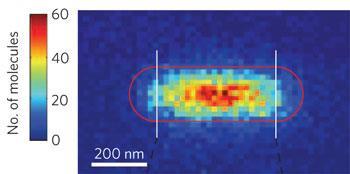The catalytic behaviour of gold nanorods varies across their surface in unexpected ways
The spread of reactivity across the surface of single nanocatalysts has been mapped for the first time by scientists in the US, with ‘surprising’ results. It is hoped that a better understanding of how such catalysts work will eventually lead to the design of more efficient versions.
‘Using super resolution imaging we can map out where catalytic reactions occur on a single nanocatalyst,’ says Peng Chen, the lead researcher based at Cornell University.1 Previously, his team designed a method for studying catalytic behaviour of individual gold nanoparticles.2 ‘We can now divide the particle into different sections: we have sub-particle resolution,’ he explains.
The team followed an oxidative deacetylation reaction - the acetyl group in a non-fluorescent substrate molecule, amplex red, was cleaved by a gold nanorod catalyst to generate fluorescent resorufin. Digital photographs of the fluorescent signals from each product molecule as it was generated on the nanorod surface were taken using a microscope. These photographs have sufficient resolution to allow researchers to see exactly where on the catalyst the products were formed.
Going against the grain
‘We can count the reaction rate at different locations,’ Chen says. When studying these results, ‘we discovered a surprising phenomenon’.
It is often true that the ends of nanorods are more reactive than the middle - because there are more corner and edge gold atoms that are not fully co-ordinated. However, Peng’s team found that in a significant fraction of nanorods the opposite was true. ‘We discovered that [often] the centre of the nanorod is most reactive, and the reactivity gradually decays towards the two ends.’

Peng’s justification for these observations is based on defects - as defect sites are known to be more reactive - and the variation in the density of defects in these different locations on a gold nanorod. ‘If there are a sufficient number of defects [in the centre], then the centre part of the nanorods will be more reactive than the ends.’
And why would there be more defects in the middle? Chen proposes that it is down to how the rods are grown. A single seed is grown outwards in two directions to form a rod. ‘The initial growth is very fast and the growth rate slows down until it finally stops.’ In the section that has grown faster (the middle part of the rods) there are more structural errors - or defects - than the parts that grew more slowly (the ends), he explains.
Robert Rioux, an expert in heterogeneous catalysis at Pennsylvania State University, US, agrees that ‘the results are at odds with the accepted catalysis principles that we learn as undergraduates.’
Describing it as ‘interesting work’ that ‘tips the iceberg’, Rioux says ideally the defects would be actually ‘seen’ using an electron microscope at the same time as the single molecule imaging is carried out. He admits this would be difficult to do practically, but says that it is needed to definitively prove that the defects are indeed responsible for increased catalytic reactivity at certain sites.
But why is this fundamental research so important? ‘Nanocatalysts can catalyse many important chemical transformations,’ explains Chen. ‘Our fundamental knowledge can help people to design better catalysts.’












No comments yet